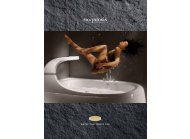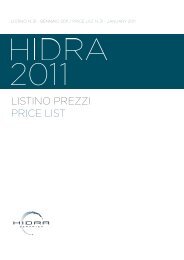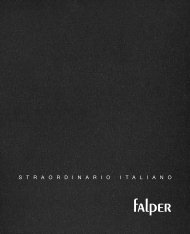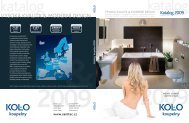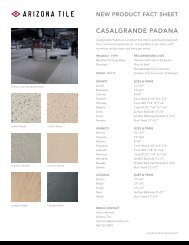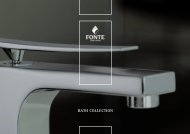DORNBRACHT - Butterfly Trading
DORNBRACHT - Butterfly Trading
DORNBRACHT - Butterfly Trading
Create successful ePaper yourself
Turn your PDF publications into a flip-book with our unique Google optimized e-Paper software.
<strong>DORNBRACHT</strong> the SPIRITof WATER Dornbracht Research Unit ETH Zurich<br />
RITUALS<br />
AND<br />
VISIONS<br />
Dornbracht Research Unit<br />
ETH Zurich<br />
ARCHITONIC<br />
Nils Becker and Tobias Lutz<br />
are the managing directors<br />
of Architonic AG, Zurich.<br />
The internationally based<br />
network, consisting of architects,<br />
designers and IT<br />
specialists, develops design,<br />
communications and information<br />
processes in the context<br />
of architecture, design<br />
and marketing. The platform<br />
www.architonic.com is an<br />
international research instrument<br />
for high-quality design<br />
products, materials and<br />
innovative concepts.<br />
Nils Becker e Tobias Lutz<br />
sono i direttori della<br />
Architonic AG, Zurigo. La<br />
rete, organizzata a livello<br />
internazionale e composta<br />
da architetti, designer e<br />
informatici, mette a punto<br />
processi di progettazione,<br />
di comunicazione e d’informazione<br />
nell’ambito dell’architettura,<br />
del design e del<br />
marketing. La piattaforma<br />
028<br />
www.architonic.com è uno<br />
strumento di ricerca internazionale<br />
per prodotti di<br />
design e materiali di prima<br />
qualità e per progetti<br />
innovativi.<br />
Nils Becker y Tobias Lutz son<br />
los gerentes de Architonic AG,<br />
Zurich. La red internacional<br />
está compuesta por arquitectos,<br />
diseñadores e informáticos<br />
que conforman los<br />
procesos de proyección,<br />
comunicación e información<br />
en el contexto de la arquitectura,<br />
el diseño y el marketing.<br />
La plataforma<br />
www.architonic.com es un<br />
instrumento internacional<br />
de investigación para productos<br />
de diseño, materiales<br />
y conceptos innovadores de<br />
calidad.<br />
RITUALS IN THE ROOM<br />
“Ritual Architecture” is for Dornbracht the result<br />
of many years of dealing with space and personal<br />
hygiene, which was given key inspiration from<br />
the context of the Statements Projects curated by<br />
Mike Meiré.<br />
It became apparent in the works of artists, designers,<br />
musicians, architects and authors that in addition<br />
to physical cleansing there is also mental<br />
cleansing, that subject matter increases in importance<br />
through conscious actions at an idealistic<br />
level, so that the mundane suddenly attains significance.<br />
Man, with his customs and rituals, is then placed<br />
at the centre of the architectural design. In contrast,<br />
the architecture of the 20 th century was characterised<br />
under the influence of modernity, predominantly<br />
by functional aspects which led to numerous<br />
standards in the built-up environment. As a spatial<br />
consequence of this functionalistic way of thinking,<br />
the bathrooms became the wet room. The individual<br />
functions such as washing, showering and<br />
bathing were optimised on the smallest possible<br />
area from a technical and hygienic perspective –<br />
i.e. they were minimised. Until now these functional<br />
elements, standardised in form and size, have<br />
been taken by many planners and architects as<br />
“given” and simply placed one after the other. On<br />
the pretext of economical and functional necessities<br />
the bathroom was increasingly faded out of<br />
architectural design, to become an anteroom.<br />
However, from the perspective of architects, it is<br />
an exciting challenge to include these topics and<br />
considerations of “ritual architecture” in the<br />
design process and to give the purely functional<br />
and technical aspects of the bathroom an added<br />
dimension of human rituals, actions and customs.<br />
This is not primarily about formal or aesthetic<br />
questions, but rather that architecture has become<br />
an interface between the user and his rituals. The<br />
Dornbracht Research Unit was set up together<br />
with Architonic at the ETH Zurich chaired by<br />
Prof. Marc Angélil (Architecture and Design) to<br />
investigate the design potential of the essence of<br />
the “ritual architecture” vision and convert it into<br />
architectural visions. Over several months model<br />
design strategies were implemented with selected<br />
students, which made the aspects of human rituals<br />
in cleansing and personal hygiene the starting point<br />
for the architectural projects. For this a special<br />
design process was developed under the scientific<br />
management of Dirk Hebel and Jörg Stollmann:<br />
1. Investigation of human actions and rituals in<br />
the bathroom including personal hygiene products.<br />
Direct notation of the observation in 1:1 models<br />
and drawings.<br />
2. Further development of the 1:1 model by confrontation<br />
of the private environment of a bathroom<br />
with the public area.<br />
3. Formulation of a thesis from the observations<br />
made.<br />
4. Testing and further development of the thesis<br />
on various building typologies, such as loft<br />
dwelling, one-family house, villa, multiple family<br />
dwelling, tower block and hotel, and their typical<br />
inhabitants.<br />
5. Development of the thesis using a concrete<br />
architectural proposal.<br />
The results are as confusing as they are eclectic.<br />
They all provide architectural visions, stimuli and<br />
inspirations to question the bathroom as a wet<br />
room and to extend it into a living space in the<br />
midst of daily rituals. The illustrated design<br />
processes encourage designers to consciously use<br />
the design potential in the exact observation and<br />
conceptual inclusion of human rituals – regardless<br />
of whether private or mundane, conscious or<br />
unconscious.<br />
RITUALI NELLO SPAZIO<br />
Per Dornbracht l’architettura rituale è il risultato<br />
dell’annoso confronto tra spazio e igiene corporale<br />
che ha trovato il nucleo della sua ispirazione<br />
nel contesto degli Statement Projects, curati da<br />
Mike Meiré.<br />
I lavori di artisti, designer, musicisti, architetti e<br />
autori hanno rivelato che ad una purificazione corporale<br />
si accompagna una purificazione mentale e<br />
che la materia acquista importanza sul piano ideale<br />
grazie alla piena consapevolezza dei gesti. Ed è<br />
così che il quotidiano all’improvviso diventa<br />
significativo.<br />
L’uomo con le sue abitudini e i suoi rituali è<br />
posto al centro della struttura architettonica.<br />
L’architettura del XX secolo, segnata dall’influenza<br />
della modernità, era improntata prevalentemente<br />
agli aspetti funzionali che hanno condotto a una<br />
sequela di standard nell’ambiente costruito. La<br />
conseguenza, in termini di spazio, di questa prospettiva<br />
funzionale è stata la riduzione del bagno a<br />
locale di servizio. Le singole funzioni, quali le<br />
abluzioni, la doccia e il bagno, sono state ottimizzate<br />
su una superficie ridotta e in base ad aspetti<br />
strettamente tecnici e igienici, insomma, sono<br />
state minimizzate. A tutt’oggi sono molti i progettisti<br />
e gli architetti che allineano in modo scontato<br />
questi elementi funzionali, standardizzati nella<br />
forma e nelle dimensioni. Col pretesto di costrizioni<br />
economiche e funzionali, il bagno è stato via<br />
via scartato dalla progettazione architettonica,<br />
scadendo a stanza di secondo ordine.<br />
Eppure, proprio dal punto di vista dell’architetto,<br />
diventa una sfida avvincente il poter includere i<br />
temi e le riflessioni sull’“architettura rituale” nelle<br />
fasi di progettazione e l’estendere gli aspetti puramente<br />
funzionali e tecnici del bagno alla dimensione<br />
di rituali, di gesti e di abitudini dell’uomo.<br />
Non si tratta quindi semplicemente di questioni<br />
formali o estetiche, quanto piuttosto di un’architettura<br />
che diventa interfaccia tra l’utente e i suoi<br />
<strong>DORNBRACHT</strong> the SPIRITof WATER Dornbracht Research Unit ETH Zurich<br />
Studies by Christina Nater<br />
029





![Katalog USAKANG retro vany [ pdf, 0.6 MB ] - Butterfly Trading](https://img.yumpu.com/47275139/1/190x134/katalog-usakang-retro-vany-pdf-06-mb-butterfly-trading.jpg?quality=85)
